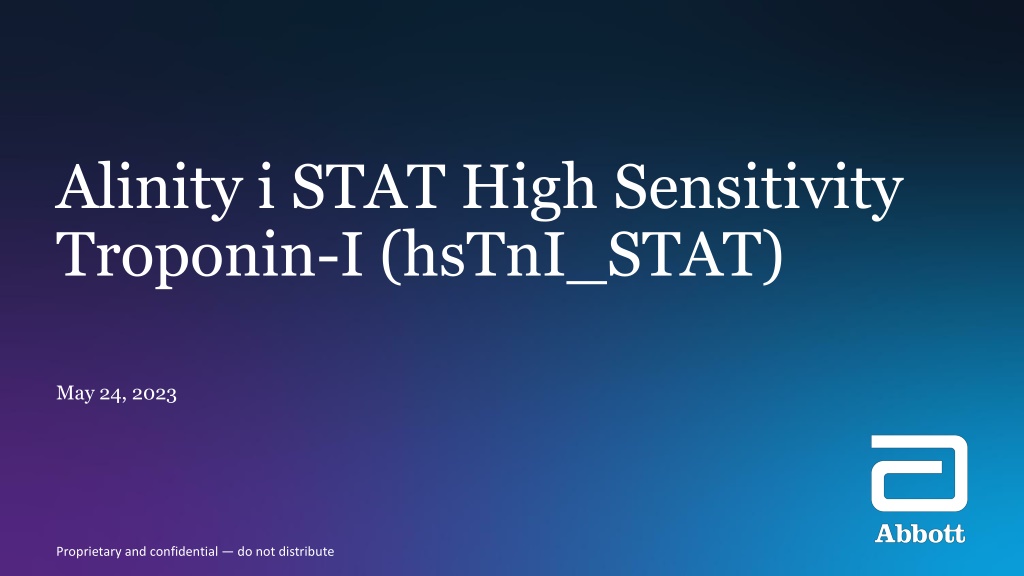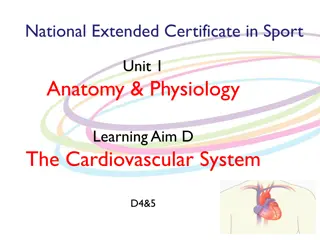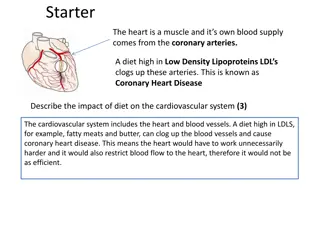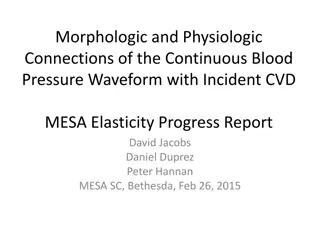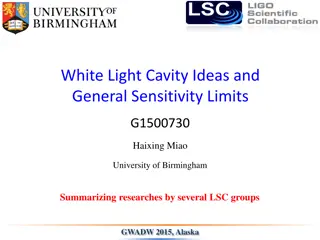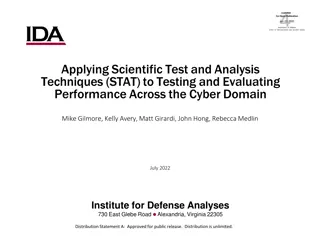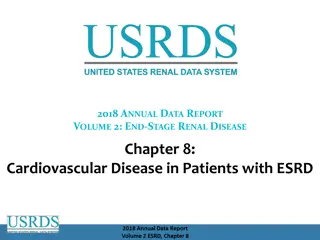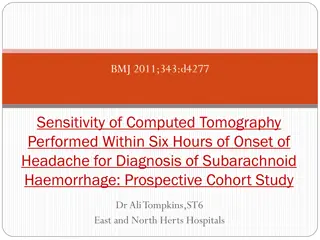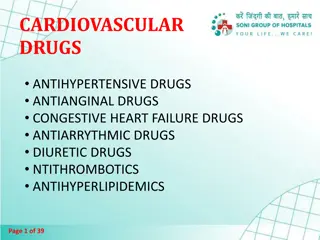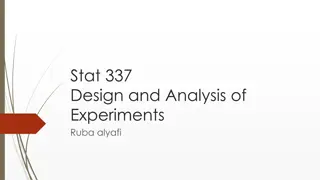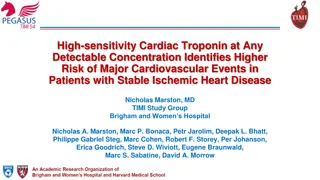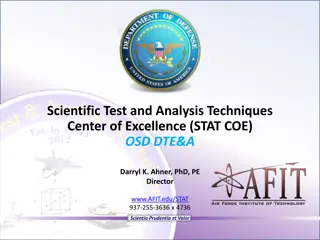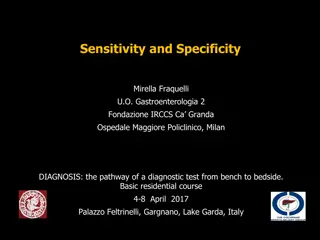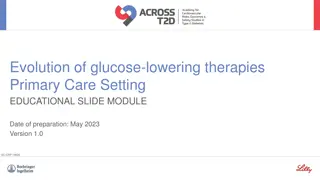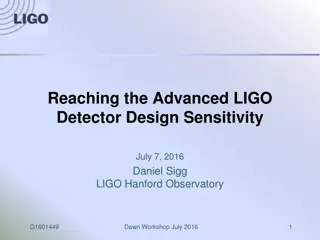Understanding Alinity i STAT High Sensitivity Troponin-I for Cardiovascular Diagnosis
Alinity i STAT High Sensitivity Troponin-I is a proprietary assay used in diagnosing myocardial infarction (MI) by quantitatively measuring cardiac troponin I in human plasma. This chemiluminescent microparticle immunoassay (CMIA) aids in the detection of MI, a significant aspect in managing heart disease, which is a leading cause of death. The assay's performance and specifications, limitations of contemporary troponin assays, and comparison with other high sensitivity troponin assays are discussed in the context of coronary heart disease and the importance of biomarkers in MI diagnosis. Early and accurate diagnosis using such assays can help streamline patient care and reduce unnecessary healthcare costs associated with suspected MI cases.
Download Presentation

Please find below an Image/Link to download the presentation.
The content on the website is provided AS IS for your information and personal use only. It may not be sold, licensed, or shared on other websites without obtaining consent from the author. Download presentation by click this link. If you encounter any issues during the download, it is possible that the publisher has removed the file from their server.
E N D
Presentation Transcript
Alinity i STAT High Sensitivity Troponin-I (hsTnI_STAT) May 24, 2023 Proprietary and confidential do not distribute
Alinity i STATHigh Sensitivity Troponin-I AGENDA *Intended use and Safety information Heart disease and myocardial infarction (MI) Diagnosis of MI: importance of biomarkers What is troponin and how is it used in suspected MI? How are hs troponin assays defined and reported? Limitations of contemporary troponin assays Comparison of Abbott contemporary and high sensitivity troponin-I (hsTnI) assays Interfering substances Alinity i hsTnI_STAT performance and specifications March 8, 2024 Proprietary and confidential do not distribute ADD-140731-USA-EN | 2
Alinity i STAT High Sensitivity Troponin-I INTENDED USE The Alinity i STAT High Sensitivity Troponin-I assay is a chemiluminescent microparticle immunoassay (CMIA) used for the quantitative determination of cardiac troponin I (cTnI) in human plasma (lithium heparin) on the Alinity i System. The Alintiy i STAT High Sensitivity Troponin-I assay is to be used as an aid in the diagnosis of myocardial infarction (MI). IMPORTANT SAFETY INFORMATION Instructions must be carefully followed. Reliability of assay results cannot be guaranteed if there are any deviations from these instructions. For laboratory professional use only. For In Vitro Diagnostic Use Rx Only (For use by or on the order of a physician only) This product contains human-sourced and/or potentially infectious components. It is recommended that these reagents and human specimens be handled in accordance with the OSHA Standard on Bloodborne Pathogens. Alinity i STAT High Sensitivity Troponin-I Package Insert: H14937R02 March 8, 2024 Proprietary and confidential do not distribute ADD-140731-USA-EN | 3
Heart disease and MI Coronary Heart Disease is the leading cause of death in the US1 Manifests most often in the form of Acute Coronary Syndrome (ACS): term used to describe Myocardial Infarctions (MI, heart attack) and unstable angina Approximately 6-8 million people/yr present to Emergency Departments with suspected MI1 Only 8-15% are having an MI so in theory the majority could be discharged2 1. Heart Disease and Stroke Statistics-2019 Update: A Report From the American Heart Association. Benjamin EJ, et al. Circulation. 2019 Mar 5;139(10):e56-e528. Sandoval et al, AJC 2017 2. 4 March 8, 2024 Proprietary and confidential do not distribute ADD-140731-USA-EN |
Diagnosis of MI: importance of biomarkers However, fears of missing an MI mean patients are frequently kept for observation and testing costing billions of dollars annually1 DIAGNOSING MI IS NOT ALWAYS SIMPLE Symptoms may not be typical even with MI EKG may not show changes even with MI Circulating biomarkers are thus critical in making the diagnosis of MI ( ruling in MI) or excluding the diagnosis of MI ( ruling out MI)2,3 About 25% of patients with MI are diagnosed from their EKG due to ST elevation or new left bundle branch block = STEMI, ST elevation MI The other 75% with MI but not STEMI = NSTEMI , non ST elevation MI People who do not have STEMI (= suspected NSTEMI) are discussed from this point on (the STEMI diagnosis is usually made without the need for biomarker results) However that is only 25% of the 8- 15% with suspected MI. Troponins are the only biomarkers recommended for this purpose2,3,4 1. 2. 3. 4. Storrow, AIM 2000 Amsterdam E et al, JACC 2014 (ACC AHA NSTEMI Guidelines) Thygesen et al, JACC 2018 Fourth Universal Definition of Myocardial Infarction Yau AA, Nguyendo LT, Lockett LL, Michaud E. Crit Pathw Cardiol. 2017 Dec;16(4):126-128 5 March 8, 2024 Proprietary and confidential do not distribute ADD-140731-USA-EN |
What is troponin? How is it used in suspected MI?1 Troponin is a protein contained in the cardiac myocytes that facilitates myocyte contraction with three subunits: troponins C, T, and I: Troponin T and I are highly specific to cardiac muscle, I more so2 Levels become elevated (>99thpercentile) when myocytes are deprived of oxygen = myocardial injury including (but not limited to) MI1 Today, detection of an elevated level of troponin (> the 99thpercentile) with a rising and/or falling pattern in the appropriate clinical setting forms the cornerstone of the diagnosis of MI1 Notably, most apparently healthy individuals (not having an MI) have small but detectable concentrations of troponin, but at these low concentrations, only high-sensitivity (hs) assays can detect it 1. 2. Thygesen et al, JACC 2018 Fourth Universal Definition of Myocardial Infarction Wens et al Circ Genetics 2016 6 March 8, 2024 Proprietary and confidential do not distribute ADD-140731-USA-EN |
Guidelines for troponin in suspected MI: AHA/ACC1 high-sensitivity cTn is preferred because it allows rapid detection of myocardial injury and has increased diagnostic accuracy 1. Gulati et al, 2021 AHA/ACC Clinical Practice Guideline 7 March 8, 2024 Proprietary and confidential do not distribute ADD-140731-USA-EN |
Guidelines for troponin in suspected MI: FUDMI1 Rise and/or Fall of troponin with at least one value >99th%ile ALL elevations >99th % are Myocardial Injury: must have rise/fall to be ACUTE NOT ALL elevations are MI 1. Thygesen et al, JACC 2018 Fourth Universal Definition of Myocardial Infarction 8 March 8, 2024 Proprietary and confidential do not distribute ADD-140731-USA-EN |
Numerous reasons for non-MI troponin elevations 1. Hoeller et al.; BMJ 2013 March 8, 2024 Proprietary and confidential do not distribute ADD-140731-USA-EN | 9
Non-MI troponin T elevations: Skeletal muscle disorders (SMD) can cause elevations in cTnT not due to cardiac disease1 hs-cTnT elevations are common in patients with active chronic non-inflammatory myopathy and myositis, but not other SMDs hs-cTnT-Elecsys concentrations were significantly higher in patients with SMD versus controls hs-cTnI concentrations were mostly similar In patients with active chronic non-inflammatory myopathy and myositis, cTnI is the preferred analyte for assessing cardiac health in general and presence of AMI 1. Mueller et al.; Cardiac Troponins and Skeletal Muscle Disease; 10.1161/CIRCULATIONAHA.121.058489 March 8, 2024 Proprietary and confidential do not distribute ADD-140731-USA-EN | 10
ALINITY I STAT HIGH SENSITIVITY TROPONIN-I High sensitivity vs. contemporary troponin assays 11 March 8, 2024 Proprietary and confidential do not distribute ADD-140731-USA-EN |
How are hs troponin assays defined and reported?1 IN 2012, A TASK FORCE CREATED BY THE INTERNATIONAL FEDERATION OF CLINICAL CHEMISTRY (IFCC) PROPOSED THAT HSTN ASSAYS BE DEFINED USING TWO PARAMETERS: The total imprecision (coefficient of variation) at the 99th %ile should be 10% Measurable concentrations below the 99th %ile should be attainable with an assay at a concentration value above the assay s limit of detection (LOD) for at least 50% (and ideally >95%) of healthy individuals In 2018, the Task Force expanded on this point by requiring both men and women individually attain measurable concentrations: at least 50% measurable concentrations above the assay s LoD IFCC also recommend that hs-cTn is reported in whole numbers, using ng/L without decimal points It is crucial that clinicians are educated on the change in units 1. Wu et al, Clin Chem 2018 March 8, 2024 Proprietary and confidential do not distribute ADD-140731-USA-EN | 12
Limitations of contemporary troponin assays CONTEMPORARY (NON HS) TROPONIN I AND T ASSAYS ARE STILL IN WIDESPREAD USE IN US Very reliable for detecting troponin levels > 99th percentile of an apparently healthy reference population1but may not be able to detect elevations as quickly or precisely as high sensitivity assays2 POTENTIALLY REQUIRE EXTENDED TIME TO DETECT TROPONIN WHICH MAY LEAD TO: Delay in the diagnosis of MI Delay in treatment for patients ultimately diagnosed with MI: time is muscle Particularly vulnerable are those with lower circulating levels of troponin e.g. Women and Early presenters (present with <2-3 hours of symptoms)3 HIGH SENSITIVITY ASSAYS CAN DETECT ELEVATED CTNI (> 99TH%) WITHIN 3 HRS AFTER THE ONSET OF CHEST PAIN4 1. Jarolim P. Clin Chem Lab Med. 2015; 53(5): 635-652 2. Wu et al, Clin Chem 2018 3. Thygesen et al, JACC 2018 Fourth Universal Definition of Myocardial Infarction 4. Thygesen K, et al. EHJ 2012;33(18):2252-2257 13 March 8, 2024 Proprietary and confidential do not distribute ADD-140731-USA-EN |
Limitations of contemporary troponin assays CONTEMPORARY (NON HS) TROPONIN I AND T ASSAYS Cannot reliably report levels well below the 99th %ile Result may appear similar whether true levels of troponin were very low or rising rapidly For example, where presentation = 0 hrs <28 ng/L and 3 hrs later <28 ng/L could represent true values such as 0 hrs 5ng/L, 3 hrs 6 ng/L or 0 hrs 5ng/L, 3 hrs 16 ng/L Clinicians are aware of limitations of current paradigms and may keep patients for observation and testing for extended periods of time, leading to increased length of stay and cost1 ABBOTT Alinity HIGH SENSITIVITY TROPONIN I ASSAY CAN REPORT LEVELS OF CTNI AS LOW AS 2.7 NG/L (LOQ) 1. Alinity i STAT High Sensitivity Troponin-I Package Insert: H14937R02 Thygesen et al, JACC 2018 Fourth Universal Definition of Myocardial Infarction 14 March 8, 2024 Proprietary and confidential do not distribute ADD-140731-USA-EN |
Contemporary troponin1,2,3,4 Limit of Detection Frequency Not Measureable! 10% CV Troponin Level Representative cartoon for contemporary assays 99th Percentile 1. Apple, F.S., et al. Clin Chem, 2012; 58(1) :54 61 2. deFilippi, C., et al. JAMA, 2010; 304(22): 2494-2502 3. Saunders, J. et al. Circulation, 2011; 123: 1367-1376 4. Atherton, JJ., et al. JACC Cardiovasc Imaging, 2010; 3: 421-428 Proprietary and confidential do not distribute ADD-140731-USA-EN | March 8, 2024 15
High sensitivity troponin Cotemporary LoD High-Sensitivity LoD Frequency Not Measureable! 10% CV of Contemporary Tnl Troponin Level 10% CV of hsTnl 99th Percentile Representative cartoon for high-sensitivity assays Proprietary and confidential do not distribute ADD-140731-USA-EN | March 8, 2024 16
Contemporary vs hs troponin assays Previous generation and contemporary troponin assays cannot detect troponin increases as quickly as high-sensitivity troponin assays March 8, 2024 Proprietary and confidential do not distribute ADD-140731-USA-EN | 17
Alinity hsTnI meets IFCC criteria for hs assay Alnity i STAT_hsTnI Precision at 99th Percentile 87.3% Coefficient of Variation (CV)** Mean (ng/L) 75.3% 63.4% Sample 5 13.9 2.7% Sample 6 15.1 4.3% Sample 7 18.2 4.5% Sample 8 20.2 3.7% Sample 9 36.9 3.2% Overall Males Females **Includes within-run and between-run variability. <5% CV near medical decision points 50% Percent detected using ARCHITECT hsTnI in healthy population studies1 Alinity i STAT High Sensitivity Troponin-I Package Insert: H14937R02 1. Abbott data on file Proprietary and confidential do not distribute ADD-145288-USA-EN | March 8, 2024 18
ARCHITECT TnI and hsTnI_STAT and Alinity i hsTnI_STAT ARCHITECT STAT TnI (LN 2K41) ARCHITECT hsTnI_STAT (LN 2R98) Alinity i hsTnI_STAT (LN 4Z21) pg/ml (ng/ml) Ng/L Ng/L Improved sensitivity with lower LoD Improvement in the 10% CV concentration without significant change to 99th percentile Analytical Sensitivity/LoD 10* 1.7** 0.9*** LoQ N/A 3.5 2.7 10% CV1 32 4.6 > 3.5 99thpercentile (overall) 28 28 27 99thpercentile (male) 33 35 35 99thpercentile (females) 13 17 14 Need for sex specific cutoffs % Detectable above LoD2 <50% of normal >50% of normal >50% of normals LoB N/A 0.9 0.0 Sample tube type Li Heparin Plasma K2 EDTA Plasma Li Heparin Plasma ***Alinity i High Sensitivity Troponin-I Package Insert: H14937R02 *ARCHITECT STAT TnI Package Insert: G10467R11 **ARCHITECT STAT High Sensitivity Troponin-I Ho3755/R01 1. Data on file at Abbott 2. Apple FS, Collinson PO. Analytical characteristics of high-sensitivity cardiac troponin assays. Clinical Chemistry. 2012;58(1):54-61 19 March 8, 2024 Proprietary and confidential do not distribute ADD-140731-USA-EN |
ALINITY I STAT HIGH SENSITIVITY TROPONIN-I Interfering substances 20 March 8, 2024 Proprietary and confidential do not distribute ADD-140731-USA-EN |
Interfering substances Alinity i High Sensitivity Troponin-I Package Insert: H14937R02 March 8, 2024 Proprietary and confidential do not distribute ADD-140731-USA-EN | 21
Hemolysis interference is an important consideration for choice of hsTnI assay Hemolysis is known to cause interference in both TnT and TnI assays1 Effects become even more important with the emergence of more sensitive troponin assays and the increased reliance on interpretation of small absolute changes1 Hemoglobinemia and hyperbilirubinemia may produce either false-positive or false-negative troponin levels, depending on the assay used and the form or subunit of troponin measured2 1. Florkowski C, Wallace J, Walmsley T, George P. The effect of hemolysis on current troponin assays--a confounding preanalytical variable? Clinical Chemistry. 2010;56(7):1195-1197. Means Jr. RT( 1 ), Masimasi N. Elevated troponin levels associated with hemolysis. American Journal of the Medical Sciences. 330(4):201-203. 2. 22 March 8, 2024 Proprietary and confidential do not distribute ADD-140731-USA-EN |
Hemolysis interference with troponin assays Hemolysis is seen more frequently in samples from ED (12.4%) compared to routine samples (1.6%)1 Susceptibility to hemolysis2: can provide inaccurate results require a redraw Increase time to diagnose create lack of confidence in results 1. 2. Burns ER, Yoshikawa; Laboratory Medicine; 2022; 33(5):378-380 Harley K etal. Clin Chem Lab Med; 2021 Proprietary and confidential do not distribute ADD-140731-USA-EN | March 8, 2024 23
Emergency department samples have a higher incidence of hemolysis compared to routine Hemolysis in samples drawn in the Emergency Department (ED) is significantly more frequent than samples drawn in routine situations1 Evaluation of hemolysis in ED samples requesting high sensitivity troponin measurement2 7% samples had Hb >0.1g/dL (competitor claim) Only 0.5% samples had Hb>0.5g/dL 1. 2. Burns ER, Yoshikawa N. Hemolysis in serum samples drawn by emergency department personnel versus laboratory phlebotomists. Laboratory Medicine. 33(5):378-380 Brunel V, Larson T, Peschanski N, Cauliez B. Evaluation of hemolysis in emergency department samples requesting high sensitivity troponin T measurement. Annals Of Clinical Biochemistry. 2012;49(Pt 5):509-510 March 8, 2024 Proprietary and confidential do not distribute ADD-140731-USA-EN | 24
ALINITY I STAT HIGH SENSITIVITY TROPONIN-I Performance and specifications March 8, 2024 25 Proprietary and confidential do not distribute ADD-140731-USA-EN |
Alinity i hsTnI methodology This assay is an automated, two-step immunoassay for the quantitative determination of cTnI in human plasma (lithium heparin) using chemiluminescent microparticle immunoassay (CMIA) technology. 1. Sample and anti-troponin I antibody-coated paramagnetic microparticles are combined and incubated. 2. The cTnI present in the sample binds to the anti-troponin I coated microparticles. 3. The mixture is washed. 4. Anti-troponin I acridinium-labeled conjugate is added to create a reaction mixture and incubated. 5. Following a wash cycle, Pre-Trigger and Trigger Solutions are added. 6. The resulting chemiluminescent reaction is measured as a relative light unit (RLU). There is a direct relationship between the amount of cTnI in the sample and the RLU detected by the system optics. Alinity i High Sensitivity Troponin-I Package Insert: H14937R02 March 8, 2024 Proprietary and confidential do not distribute ADD-140731-USA-EN | 26
Alinity i hsTnI methodology March 8, 2024 Proprietary and confidential do not distribute ADD-140731-USA-EN | 27
Alinity i STAT High Sensitivity Troponin-I assay Method & Format 2-Step CMIA Assay with STAT protocol capability Result Unit ng/L; alternative SI unit = pg/mL Reportable Interval AMI = 2.7 3600.0 ng/L EMI = 3600.0 60,000.0 ng/L Time to First Result1 STAT 18 min Control Levels2 Low: 20 ng/L; 12.0 28.0 ng/L Medium: 200 ng/L; 120.0 280.0 ng/L LoQ 2.7 ng/L LoD 0.9 ng/L LoB 0.0 ng/L 99th Percentile Overall = 27 ng/L Females = 14 ng/L Males = 35 ng/L Specimen Type Plasma: Lithium Heparin Sample Volume 160 uL Alinity i High Sensitivity Troponin-I Package Insert: H14937R02 1. Alinity Systems Operation Manual 96211-119 2. Alinity i hsTnI Control Package Insert March 8, 2024 Proprietary and confidential do not distribute ADD-140731-USA-EN | 28
Specimen specifications Specimen Type Temperature Max Storage Time Special Instructions Plasma Lithium heparin with or without separator Room temperature (15-30oC) 8 hours Specimens may be stored on the red blood cells. Only plasma tubes containing dried lithium heparin have been validated for use with this assay. Other specimen types and collection tube types have not been verified with this assay. Performance has not been established for the use of cadaveric specimens or the use of body fluids other than human plasma. The instrument does not provide the capability to verify specimen type. It is the responsibility of the operator to verify that the correct specimen types are used in the assay. Alinity i High Sensitivity Troponin-I Package Insert: H14937R02 29 March 8, 2024 Proprietary and confidential do not distribute ADD-140731-USA-EN |
